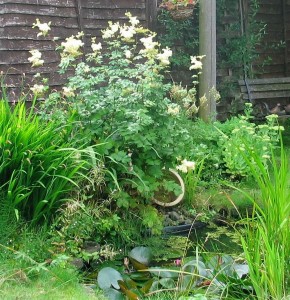 This must be a photo from previous years, because this year these particular plants have been hit by mildew. Fortunately there are others, so I have already dried dome of those gilt flossy flowers to use in herb tea for flu, a soothing cream for aching joints and for an interesting moisturiser I found in Lesley Bremmess’ book World of Herbs, made from meadowsweet and buttermilk.
This must be a photo from previous years, because this year these particular plants have been hit by mildew. Fortunately there are others, so I have already dried dome of those gilt flossy flowers to use in herb tea for flu, a soothing cream for aching joints and for an interesting moisturiser I found in Lesley Bremmess’ book World of Herbs, made from meadowsweet and buttermilk.
Meadowsweet is a plant that likes damp places, and I associate it with riverbanks and especially canal sides, but it seems to grow along all the road verges around here. I love that colour combination it develops if it gets enough sun – rich creamy flowers, dark yellow-green leaves and crimson stems – it would be a serene and restful decorative scheme to live with.
Books would tell you up till recently about the use of meadowsweet as a strewing herb, and it must have been enormously refreshing to walk over the flowers with their light, sweet almond scent on a hot sultry day. It is only recent writers who include the anti-inflammatory properties of this herb.
But it is a reminder that summer is at its peak. Already our wild flowers have gone from the sparky bright reds and yellows, blues and pinks of earlier in the year, and the road sides are a wash of quieter buff and biscuit shades – hogweed and wild parsnip, duller pinks like fireweed and purples of knapweed and thistle. All this years fledglings are full grown, blundering about the gardens in their natty juvenile plumage, eating everything from the strawberries to the young frogs out of the pond.But on the plus side, the annual plague of harvest mites doesn’t seem to be happening this year, so maybe all the young birds have dealt with it? It’s too tempting to divide wild things into friends and foes (birds and bees good, slugs and harvest mites evil), but if you go out into the wild, as Gary Snyder says, the only rule for everything is ‘your ass is lunch’. Sometimes you eat, sometimes you get eaten.
Leave a Reply